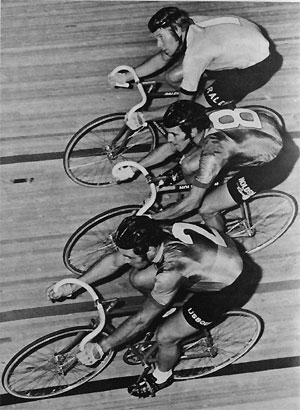|

|
|
Severens leads Dean and Pijnen at Wembley
|
|
Devil-take-the-hindmost
The most popular of all the events during the SKOL 6. Eleven riders start in the race with an elimination every three laps for the last man across the line. This process of elimination continues until only two riders are left on the track to decide the winner of the race. During the Devil-take-the-hindmost the focal point of the racing is the rear of the field.
Sprints
SKOL 6 sprints are raced over a distance of 10 laps with one rider from each of the eleven teams on the track.
Cycling sprints are quite unlike go all the way short distance events of athletics. The riders concentrate all the action into the last few laps. The reason being that a rider taking the lead for a long way, acts as a pacemaker for his opponents and will invariably be beaten by the other competitors who have sheltered in his slipstream and used the front runner as a marker.
The tactic of the cyclist sprinter is basically to time the launching of his effort from the front at a point where he knows he can maintain his top speed until the finishing line and hold off the attacks of his opponents. If the rider's speciality is a fast finish and he prefers to ride his race from the rear position, he will try to force the pace using his opponent as an aiming point.
Because the action is concentrated in cycling sprinting, the riders in the SKOL 6 will cover the last lap at speeds over 40 mph.
On the tightly banked SKOL 6 track sprints are rarely won from further back than sixth position.
Match Race Sprinting
During each session of the SKOL 6 the winners of the two Devil-take-the-hindmost races meet in a match race.
With only two riders on the track, the tactics of cycling sprinting become more apparent, with neither man eager to initiate the action. The task of the leading rider is to dictate the tempo of the first laps to the point at which the sprint will begin.
At the same time the rider in the rear position will do all he can to force the pace into an early sprint or take any opportunity to catch his opponent unawares by diving underneath for a surprise attack.
Motorpaced Racing
The motors used for pacing at the SKOL 6 are French DERNY machines specially built for this type of work. The pacers are ex-professional cyclists and predominantly Belgian. The motors are capable of up to 60 mph. They are pedal assisted on a very high gearing ratio, the traction being necessary for accurate steering on the small tracks.
Five riders start in the motorpaced events. The riders draw for starting position and line up one behind the other. On making contact with the motor, the rider obtains as much shelter as possible by riding with his front wheel only a fraction of an inch away from the rear wheel of the motorcycle. 'G' forces in each banking make motorpaced cycling an exacting event.
The pacemakers wear helmets with earphones for ease of communication with the rider. It is the experienced pacemaker who decides the moment to attack or defend. Though the pacemakers appear to carry out their task in a leisurely manner, skill and superb timing are essential requirements.
Teams Racing
The basis of Sixday racing is the teams race, sometimes called a madison or a chase. Basically it is a relay race with one rider in the race at all times while one rider rests by riding slowly on the top half of the track, above the blue line.
The aim is to gain a lap advantage over the field. A lap is gained when the team has reached the last man in the field.
The lap position of the teams is continuously changing in a fast chase and the spectators' guide to the situation is the electrical scoreboard.
|